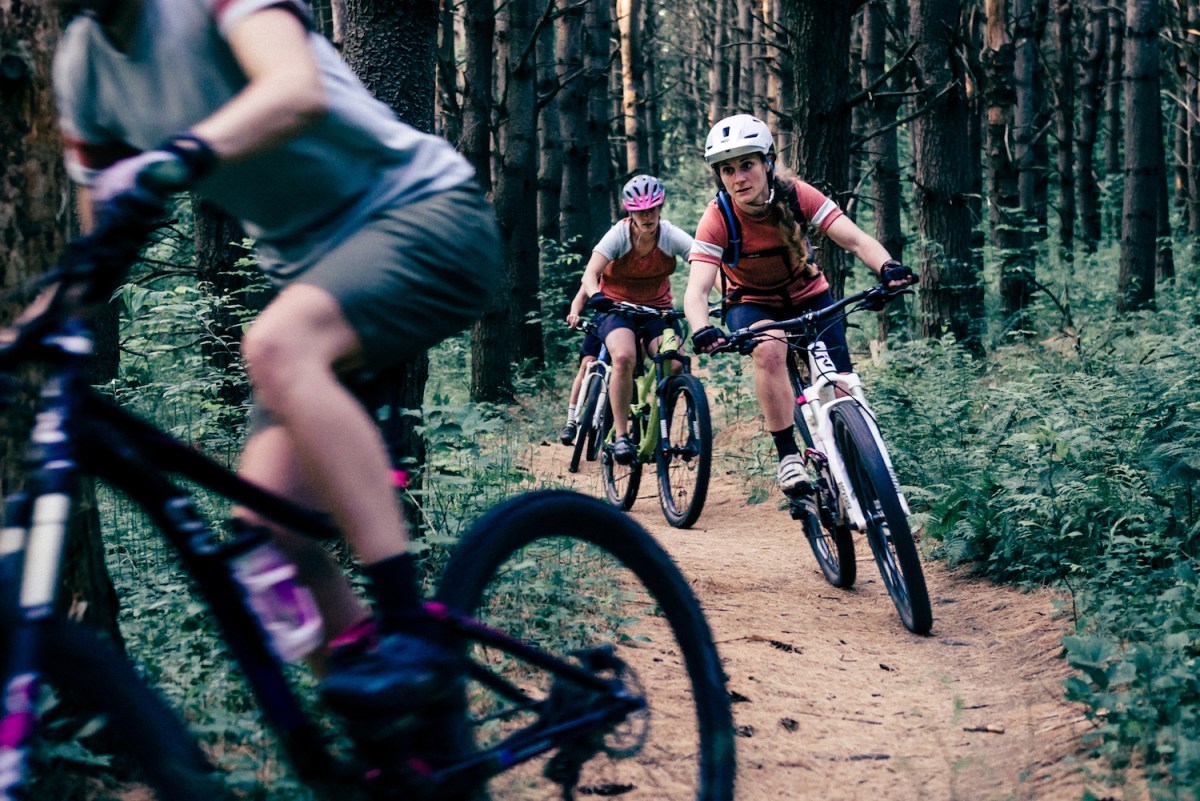Just outside Matt Baatz’s house in Pittsfield, Vermont, a 25-mile network of mountain bike trails climbs about 1,000 vertical feet. Baatz is the trail manager for Green Mountain Trails (GMT), a community group that built the mix of flowy singletrack and narrow, rugged routes. And he rides them daily—unless he drives either way along Vermont’s Scenic Route 100 to pedal the other trail networks that dot the Green Mountain foothills.
“The next logical step is just to connect these networks, and make one awesome option to travel from north to south,” he says.
Enter the Velomont Trail, a proposed mountain bike route that would travel more than 130 miles from Killington north to Stowe over state, federal and private land. The Vermont Mountain Bike Association announced the project in 2017 as a collaborative effort between six member chapters along the Route 100 corridor: Killington Mountain Bike Club, GMT, Rochester/Randolph Area Sports Trail Alliance, Mad River Riders, Waterbury Area Trail Alliance, and the Stowe Trails Partnership. The name combines the French words for bike and mountain.
The planned route includes 40 miles of existing trails, 10 miles of road connections and 80 miles of singletrack built in the next 10 years. When completed, the trail will be 70 percent singletrack. And the Vermont Huts Association, a nonprofit launched in 2016 to develop a statewide network of backcountry shelters, plans a dozen shelters on the Velomont.
“Long-distance riding gives people a wilderness experience,” says VMBA Executive Director Tom Stuessy. “The Velomont will link hundreds of miles of trail where each individual network is part of a strong rural community that embraces outdoor recreation in unique and different ways.”

Erin Pichiotino banks a turn on a trail in Waterbury, Vermont, a region that would be connected to the Velomont Trail. Photo Credit: Ryan Bent
Work begins this year, pending approval from the United States Forest Service (USFS). A 15-mile connector trail, the first phase of the Velomont Trail, would leave Pittsfield to travel through the Green Mountain National Forest, pass a hut site at Chittenden Brook Campground, and arrive at the Rochester Ranger Station. The Forest Service was accepting public comments on this proposal through July 5.
“I would say the Velomont Trail is in keeping with the character of Vermont,” says Holly Knox, a recreation program manager with the Green Mountain National Forest. “We have multiple long-distance opportunities across the state, and that provides a way to connect people to state and federal public lands.”
In Vermont, other north-south options include the Long Trail, a 272-mile hiking route completed in 1930, and the Catamount Trail, a ski tour established in 1984 that runs 300 miles. There’s also the Vermont Association of Snow Travelers; 127 snowmobile clubs statewide maintain 4,700 miles of trail—a model that inspired mountain bikers.
“It was always the goal to go farther,” says John Atkinson, executive director of Mad River Riders . He’s been building mountain bike trails for 26 years. “It took time to prove our legitimacy and get permission from public and private landowners. Now we have a tremendous amount of momentum.”
That’s true across the state. Ben Colona is the president of the nonprofit Killington Mountain Bike Club, and also manages the bike park at Killington Mountain Resort. “We’ve seen a ton of growth at the resort,” he says. “We went from 2,000 [riders] in 2011 to 24,000 last year.” And the state’s marquee mountain bike success story, Kingdom Trails in northeastern Vermont, demonstrates the economic impact riders bring to isolated rural communities. First established in 1994, the multiuse trail network offers more than 100 miles of bike trails; a 2016 study found that trail users brought $7.9 million to the area.
Those positive numbers could be spurred by the sport’s growth: The Outdoor Industry Association reports mountain bike participation has increased from 6.8 million in 2007 to 8.6 million in 2016. “We know what matters most to people is trails close to home,” says International Mountain Bicycling Association Communications Director Katherine Fuller. “But as people get better and become more engaged with the sport, they want a different adventure.” That’s contributed, Fuller says, to the rise of bikepacking, where riders extend trips by carrying camping supplies, and more interest in multi-day mountain bike trips.
Nationally, that’s available on the Colorado Trail and the Arizona Trail, both National Scenic Trails with large portions open to mountain bikers willing to carry tents and camp gear. And the San Juan Hut System offers a 215-mile hut-to-hut route from Telluride, Colorado, to Moab, Utah. More huts sited with backcountry skiers in mind, and private yurt operators, offer multiday excursions. But the Velomont Trail is unique: When complete, it will be a one-of-a-kind hut network linked by purpose-built, multiuse mountain bike trails.
“It’s an alternative way to go long distance, and people increasingly want that experience,” says Jessica Savage, the recreation coordinator for the Vermont Department of Forests, Parks and Recreation. “We want to make sure that vision gets legs in a way that’s environmentally responsible.”
There are more hurdles ahead, including funding. For now, VMBA offers members an add-on option at $25.20, with proceeds dedicated to the Velomont. But back in Pittsfield, Baatz trusts in the vision for a new entry in the Green Mountain State’s history of outdoor pursuits. “A hundred years ago, John Taylor built the Long Trail so hikers could appreciate the land around them,” says Baatz. “Now we have a similar thing happening for mountain bikes.”
